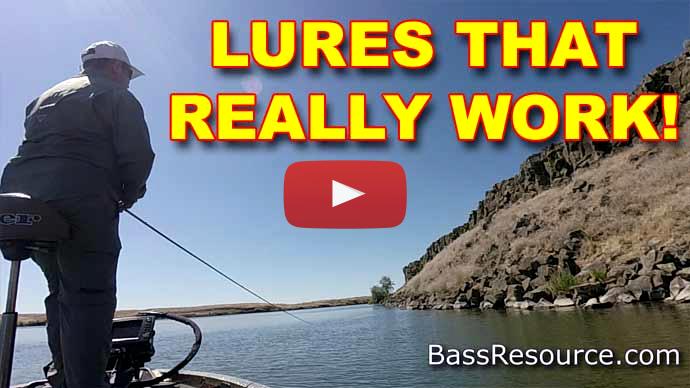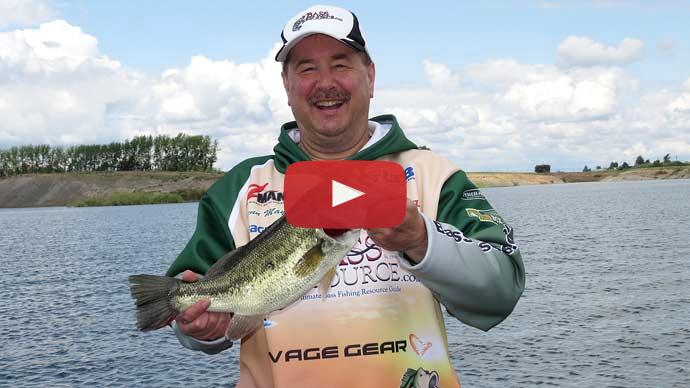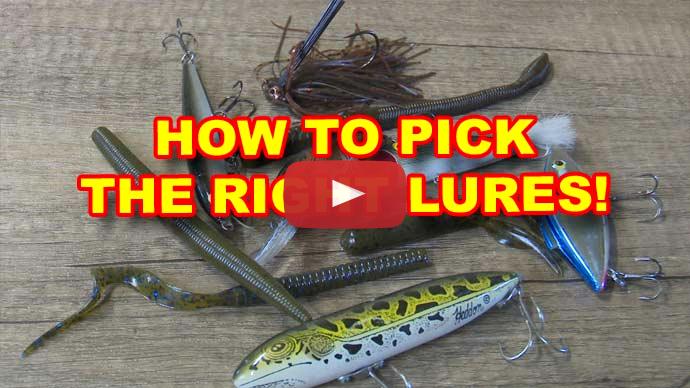Hey, guys. Gerald Swindle. Welcome to Bassresource, and we're going to be doing a couple of videos here on a vast topic of how do I approach lakes on seasonal patterns and what would I look for, what would dictate that. But, first, we want to talk about the seasons. Is there just a fall, summer, spring?
No. In bass fishing, there's multiple seasons inside of a season. You can have...so let's just start with, say, January. January to February in a lot of places is the end of the winter season. You know, it's when it's been the coldest. The water is usually the clearest. That's a whole different season within itself. You jump over into March, head in, you could have an early spring season where the water don't warm up more than 8 or 10 degrees, but the fish are still in that kind of a late late winter pattern. Then you have summer. Then you have the dog days of summer, which can be extremely hot, and they'll ease into what we call the early fall bite when the nights just barely start getting cooler, the shad first start migrating in the creeks. So that's an early early fall bite, totally different than a late fall bite. That late fall bite in the south is just October, November. That's when the water really starts to get down to 60 degrees, 55 degrees, and the shad migrate, they start schooling, totally different season.
And then from December into back in the mid-January, we go back into the hard winter season where fish will congregate deep and do that. So we're going to try to address those and let you understand that there's never just a cut season in a season. So sometimes if I say a late summer pattern, it's going to be different than an early summer pattern. So that's kind of my take on it. That's video one, so we'll get ready to start in on this next segment, and we'll start with the spring.
Let's look at spring fishing. Spring fishing can be everything from lipless crankbaits to DT6 where fish are just starting to come in. So when we say spring, we're talking about the waters got up to 55, 60 degrees. Some fish are just starting to bed. A lot of fish are just starting to move in. They're working their way through the creek channels headed up into the creeks into the main lake pockets off the main lake. But what I do when I get to a lake, and it's the simplest thing you can remember, is water temperature will dictate how you start and where you break down a lake at the first.
In the spring, year round, I'm the big component of watching water temperature. I know that in the spring, once the water temperature stabilizes around 58 to 60, it keeps it over 3 or 4 nights, key, 3 or 4 nights in a row, not days. Water might get up to 61 during the day and drop back to 55 at night. That's not great spawning conditions for most of the world. What you wanna do is see it's 58 to 61 maintained for 3 nights in a row. Then I can say we're into a good hard spring where the spawn is starting to take effect. The fish are moving in. They're gonna stay on bed. The water's been stable enough, they're gonna do it. So that's that key spring bite you're looking for, is the spawn. That's when you see it happen. It's all driven by moon phase, the amount of sunshine and the days getting longer, and the water temperature. So that's a little confusing sometimes.
Some people think, well, the water jumped up 4 degrees, they should start spawning. No, it has to all come together from water temperature, amount of sunlight, you know, days getting a little longer, all that's got to go together. So if I'm...that pattern's pretty easy. You know, I'm going to look for the clearest water, where I got the best visibility, a lot of it be protected from the wind, and I'm going to look for sight fish. If I bounce into a late spring, a lot of those fish are starting to guard fry, you know. So that may be a whole different pattern. I'm going to use the basic setup and area and the breakdown to get in those areas, but all I'm going to change is my techniques.
Instead of physically fishing for the bass on bed, I'm going to be throwing a pop, some type of popping bait around, a prop bait, a wacky worm. I'm going to be trying to catch some fish guarding fry. Could be the male. Some of the lakes, they're 3 and 4-pound males. Some of the females will be out in the middle of the pocket. This is a late spring bite. We're going to look at the water temperature from, say, 61 to 68, 70 degrees. This is when it's all going down. That late spawn, first of the post-spawn. They're just guarding fry. They're right there. But when I jump over into...you know, I get to the end of April, starting to May, then I'm starting to look at what we would call the hard post-spawn, where most of the fish have now pulled off. They're not guarding fry. None are left on the bed. They're starting to drift out to the main lake. Drift out, drift out, drift out.
So, now, you're going to start picking up a topwater bait. So I'm going to follow them out of those spawning areas and work my way back out toward the main lake, and I'm going to be stopping on points, what I call rest areas, little areas that the fish can go and just stop off on, stop off on, and stop off on and recover. You're going to want to bait around. The fish is naturally going to want to eat a lot when he comes off the bed. Him and her are going to be hungry. So, yeah, your topwaters are going to be a dominant choice, but you're going to be looking at main lake points and long flats that run off right outside those spawning areas. That's where the fish are going to come out to.
So, now, we jump right through the post-spawn. We caught some on topwater. Now, that sun's out. She's done got hot. Now, we're into that true summer pattern. The fish have migrated back out on the creek channels, river channels. They're going to be really, really kind of influenced by current. If the river or the lake you're fishing has current, they're going to crave that current because it's going to flow the bait to them. They don't have to work as hard to eat. So you're going to want to look from like, say, June, July. Those two months right there, that's the dead summer pattern that's setting up on it. We like to call that the fish get out wide. They get out way offshore, humps, channels, the edge of the river channel, gravel bars. You're going to be fishing anywhere from 15 to 25 foot deep.
What's going to determine how I do that? Water temperature. Nicely, I know the water temperature is way up, so the fish are out there, but I'm going to use my electronics to try to find the best places to fish, whether it be a hump, a channel swing. I'll use LakeMaster, break it down, look at the depth. If I ever get a bite in that time of the year, I can highlight that depth on this graph, and then I can keep running that depth to see if I can put a pattern together.
So the late summer pattern is one of my funnest patterns because once you find them, there's a bunch of them there. They congregate back up. That leads us into that kind of that early early. When people say early fall bite or late late summer bite, that's that September and August where you're just thinking about deer hunting or something, everything but fishing because it's so hot. But let me tell you, it can be one of the best topwater bites, shallow, especially if you live on a grass lake. That's right when the frog bite starts to kind of really start to happen again.
Early September, if you find the frog bite and all these vegetations are matted up places, it's going to be phenomenal because you'll be the first one there. So remember that by that time, the end of the summer, the fish are looking for shade, but a lot of the bream and everything are moving back shallow. They'll move in with them. So that's the hardest time of the year that you fish. And they say it's the dog days of summer in the south. They mean it. And the old people used to say that because it got so hot in the south that the dogs would just lay around on the porch. That old people said the dogs won't even go play because it's so hot.
So you think about that. If the water's that hot, men that hot, naturally big fish are going to look for shade. So what happens? The grass were to mat up. Vegetation gets real thick. They can get in there. It's shade. It's a little cooler, and they get a different look. So you get through September and August. Now, we're kind of into that early fall. And I do enjoy early fall. It can be a little tricky sometimes because the first couple of cool nights we get, we think they all just gonna run to the bank or there's gonna be a million of them back here. But a lot of them will be transitioning in. The big groups of them back on some of the same exact points that we caught them on in hard post-spawn.
They're moving their way back in the creeks. They're gonna stop on some of the same points. But this time they're not gonna be on the bottom. They're gonna be on the top. They're gonna be chasing bait. You're gonna see them breaking the surface. It's great topwater season. Then they're kind of migrating in. I love that time of year. It's a little tricky. That's the weirdest time. People say it's the fall bite. It ain't quite, quite got blazing cool yet, and they moved them in. But when you hit that October, November, and that water temperature returns back down into the lower 50s, that bait fish pile to the creeks. They follow creek channels in. The bait moves in. You'll see them in giant groups. And it's the bait, it's the fry from this year's shad spawn. They're all together. And bass will naturally start feeding on them.
But one of the things you wanna remember in the hard fall pattern is usually faster-moving baits are better. You're gonna mimic the shad in every way you can. And a lot of times the bait is gonna be small. So when you get to that late fall pattern, remember OG told you, sometimes go smaller means bigger.
So that's a quick rundown of how I look at the seasons through everywhere I go. They all have a micro season inside the season. And I simply use the water temperature to determine where I start looking for bass. I know that's a lot thrown at you today on Bassresources from the redneck from Alabama. But it's a simple guideline on how to catch fish and find fish year round all over the country.



